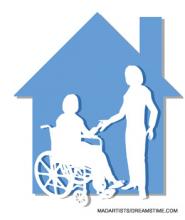User login
An abstract presented at HM11, “Purposeful Visits for Hospitalized Elderly Patients,” describes a service at the University of Colorado Hospital (UCH) in Denver that has shown improvements in participating patients’ mood, agitation, and orientation.
The purposeful-visit program was started, says senior author Ethan Cumbler, MD, a hospitalist at UCH and director of its Acute Care for the Elderly Service, because hospitals often are a profoundly unfriendly environment, especially for vulnerable, chronically ill patients. “It’s a social and intellectual desert where patients don’t get the stimulation they would receive at home,” he adds.
The program was established to leverage professional resources by training a core cadre of four to six volunteers in communication techniques (e.g. open-ended questioning), says the hospital’s recreational therapist, William Mramor, CTRS, MS. Charge nurses help identify patients and topics to explore, and the volunteers use a prepared script to help guide interactions, Mramor says.
“The purposeful visit directly addresses issues of patients’ feelings and promotes a patient-centered hospital experience,” he says.
Based on assessments using a five-point scale, with scores ranging from “worsening” (1 or 2) to “improving” (4 or 5), patient mood was rated 3.94 by the volunteers and 3.65 by the nurses. Slightly lower scores were recorded for patient agitation and patient orientation but in every case showed improvement.
“What distinguishes these purposeful visits is their goal of enhancing patients’ memory, decreasing their loneliness, and helping them understand the value of reconnecting to things they enjoy,” says Dr. Cumbler. —LB
Technology
New E-Pillbox Actively Monitors Med-Recon, Fights Readmissions
Electronic pillboxes are nothing new, but some hospitalists might not have seen the latest one.
Earlier this year, the FDA approved PillStation, a traditional pillbox married to a software system that uploads data to the system’s maker, SentiCare Inc., which then monitors how well a patient is following their medication regimen. The four-year-old medical firm is pitching the product to hospitals and accountable-care organizations (ACOs), among other potential clients.
And in a sales pitch practically tailored to HM, SentiCare bills itself as a medication adherence system that can help fight readmissions, particularly in cases of chronic disease or congestive heart failure. The device actually takes photographs of the pills to be taken and can record whether a patient has removed them from the device.
“Hospitals need to dramatically reduce their readmissions rates,” Yogendra Jain, chief technology officer and cofounder of SentiCare, wrote in an email to The Hospitalist. “One critical factor is medication and hospital discharge instruction adherence. Through its embedded camera, PillStation can confirm that from day one of departing the hospital... medications are loaded correctly and that the patient is taking it on time.”—RQ
Quality
Home Healthcare Has Fewer Rehospitalizations
A recent study by Avalere Health, a healthcare advisory firm based in Washington, D.C., found that providing home healthcare after hospital discharge for patients with three common conditions resulted in fewer hospital readmissions than for similar patients receiving other post-acute services. Those comparable services included long-term acute-care hospitals, inpatient rehabilitation facilities, skilled nursing facilities, and hospices.
“We tried to control for hospital DRG, severity of illness, and comorbidities,” says Emil Parker, Avalere’s director of post-acute and long-term-care practice, although he acknowledges the complexities of risk adjustment.
In comparing Medicare spending and rehospitalization rates after initial hospital visits for patients with diabetes, COPD, and congestive heart failure from 2006 to 2009, the study estimated that referrals to home healthcare resulted in $670 million in Medicare savings from 20,426 fewer readmissions.
“Hospitalists should think about the continuum of institutional support for patients discharged from the hospital with significant support needs,” Parker says. “Our study shows that in this population, provision of home healthcare is cost-effective and benefits patients by improving the continuity of their care.” —LB
Patient Safety
L.A. Hospitals Add HM for Medicaid Patients
In June, Anthem Blue Cross of Woodland Hills, Calif., began offering covered hospitalist services to its adult managed-care members covered by Medi-Cal, the Medicaid program for California residents, at 24 hospitals in Los Angeles County. The service is designed to take advantage of the existing hospitalist presence in those hospitals, which is provided by ApolloMed, a Glendale, Calif.-based medical management services company.
The hospitalist service is designed to enhance quality of care during hospitalization, reduce costs, and plan for more timely discharges and transitions to outpatient care. ApolloMed plans to add more hospitals in the region to the program, as well as additional post-discharge outpatient clinics. —LB
Technology
By the Numbers: 5.9
The percentage of total national health expenditures spent on medical devices in 2009, according to a report released in June by the Advanced Medical Technology Association.
The report highlights that while technology is washing over medicine, and HM in particular, with the adoption of electronic health records, portable ultrasounds, and tablet computing, the $147 billion spent on medical devices in 2009 represented just 5.9% of the $2.5 trillion in national health spending.
The trade group also reported that the average annual rate for medical device spending increased 7.5% in the 20-year period that ended in 2009. That outpaced the average annual rate for overall national heath expenditures, which ticked up 7% over the same time period. —RQ
An abstract presented at HM11, “Purposeful Visits for Hospitalized Elderly Patients,” describes a service at the University of Colorado Hospital (UCH) in Denver that has shown improvements in participating patients’ mood, agitation, and orientation.
The purposeful-visit program was started, says senior author Ethan Cumbler, MD, a hospitalist at UCH and director of its Acute Care for the Elderly Service, because hospitals often are a profoundly unfriendly environment, especially for vulnerable, chronically ill patients. “It’s a social and intellectual desert where patients don’t get the stimulation they would receive at home,” he adds.
The program was established to leverage professional resources by training a core cadre of four to six volunteers in communication techniques (e.g. open-ended questioning), says the hospital’s recreational therapist, William Mramor, CTRS, MS. Charge nurses help identify patients and topics to explore, and the volunteers use a prepared script to help guide interactions, Mramor says.
“The purposeful visit directly addresses issues of patients’ feelings and promotes a patient-centered hospital experience,” he says.
Based on assessments using a five-point scale, with scores ranging from “worsening” (1 or 2) to “improving” (4 or 5), patient mood was rated 3.94 by the volunteers and 3.65 by the nurses. Slightly lower scores were recorded for patient agitation and patient orientation but in every case showed improvement.
“What distinguishes these purposeful visits is their goal of enhancing patients’ memory, decreasing their loneliness, and helping them understand the value of reconnecting to things they enjoy,” says Dr. Cumbler. —LB
Technology
New E-Pillbox Actively Monitors Med-Recon, Fights Readmissions
Electronic pillboxes are nothing new, but some hospitalists might not have seen the latest one.
Earlier this year, the FDA approved PillStation, a traditional pillbox married to a software system that uploads data to the system’s maker, SentiCare Inc., which then monitors how well a patient is following their medication regimen. The four-year-old medical firm is pitching the product to hospitals and accountable-care organizations (ACOs), among other potential clients.
And in a sales pitch practically tailored to HM, SentiCare bills itself as a medication adherence system that can help fight readmissions, particularly in cases of chronic disease or congestive heart failure. The device actually takes photographs of the pills to be taken and can record whether a patient has removed them from the device.
“Hospitals need to dramatically reduce their readmissions rates,” Yogendra Jain, chief technology officer and cofounder of SentiCare, wrote in an email to The Hospitalist. “One critical factor is medication and hospital discharge instruction adherence. Through its embedded camera, PillStation can confirm that from day one of departing the hospital... medications are loaded correctly and that the patient is taking it on time.”—RQ
Quality
Home Healthcare Has Fewer Rehospitalizations
A recent study by Avalere Health, a healthcare advisory firm based in Washington, D.C., found that providing home healthcare after hospital discharge for patients with three common conditions resulted in fewer hospital readmissions than for similar patients receiving other post-acute services. Those comparable services included long-term acute-care hospitals, inpatient rehabilitation facilities, skilled nursing facilities, and hospices.
“We tried to control for hospital DRG, severity of illness, and comorbidities,” says Emil Parker, Avalere’s director of post-acute and long-term-care practice, although he acknowledges the complexities of risk adjustment.
In comparing Medicare spending and rehospitalization rates after initial hospital visits for patients with diabetes, COPD, and congestive heart failure from 2006 to 2009, the study estimated that referrals to home healthcare resulted in $670 million in Medicare savings from 20,426 fewer readmissions.
“Hospitalists should think about the continuum of institutional support for patients discharged from the hospital with significant support needs,” Parker says. “Our study shows that in this population, provision of home healthcare is cost-effective and benefits patients by improving the continuity of their care.” —LB
Patient Safety
L.A. Hospitals Add HM for Medicaid Patients
In June, Anthem Blue Cross of Woodland Hills, Calif., began offering covered hospitalist services to its adult managed-care members covered by Medi-Cal, the Medicaid program for California residents, at 24 hospitals in Los Angeles County. The service is designed to take advantage of the existing hospitalist presence in those hospitals, which is provided by ApolloMed, a Glendale, Calif.-based medical management services company.
The hospitalist service is designed to enhance quality of care during hospitalization, reduce costs, and plan for more timely discharges and transitions to outpatient care. ApolloMed plans to add more hospitals in the region to the program, as well as additional post-discharge outpatient clinics. —LB
Technology
By the Numbers: 5.9
The percentage of total national health expenditures spent on medical devices in 2009, according to a report released in June by the Advanced Medical Technology Association.
The report highlights that while technology is washing over medicine, and HM in particular, with the adoption of electronic health records, portable ultrasounds, and tablet computing, the $147 billion spent on medical devices in 2009 represented just 5.9% of the $2.5 trillion in national health spending.
The trade group also reported that the average annual rate for medical device spending increased 7.5% in the 20-year period that ended in 2009. That outpaced the average annual rate for overall national heath expenditures, which ticked up 7% over the same time period. —RQ
An abstract presented at HM11, “Purposeful Visits for Hospitalized Elderly Patients,” describes a service at the University of Colorado Hospital (UCH) in Denver that has shown improvements in participating patients’ mood, agitation, and orientation.
The purposeful-visit program was started, says senior author Ethan Cumbler, MD, a hospitalist at UCH and director of its Acute Care for the Elderly Service, because hospitals often are a profoundly unfriendly environment, especially for vulnerable, chronically ill patients. “It’s a social and intellectual desert where patients don’t get the stimulation they would receive at home,” he adds.
The program was established to leverage professional resources by training a core cadre of four to six volunteers in communication techniques (e.g. open-ended questioning), says the hospital’s recreational therapist, William Mramor, CTRS, MS. Charge nurses help identify patients and topics to explore, and the volunteers use a prepared script to help guide interactions, Mramor says.
“The purposeful visit directly addresses issues of patients’ feelings and promotes a patient-centered hospital experience,” he says.
Based on assessments using a five-point scale, with scores ranging from “worsening” (1 or 2) to “improving” (4 or 5), patient mood was rated 3.94 by the volunteers and 3.65 by the nurses. Slightly lower scores were recorded for patient agitation and patient orientation but in every case showed improvement.
“What distinguishes these purposeful visits is their goal of enhancing patients’ memory, decreasing their loneliness, and helping them understand the value of reconnecting to things they enjoy,” says Dr. Cumbler. —LB
Technology
New E-Pillbox Actively Monitors Med-Recon, Fights Readmissions
Electronic pillboxes are nothing new, but some hospitalists might not have seen the latest one.
Earlier this year, the FDA approved PillStation, a traditional pillbox married to a software system that uploads data to the system’s maker, SentiCare Inc., which then monitors how well a patient is following their medication regimen. The four-year-old medical firm is pitching the product to hospitals and accountable-care organizations (ACOs), among other potential clients.
And in a sales pitch practically tailored to HM, SentiCare bills itself as a medication adherence system that can help fight readmissions, particularly in cases of chronic disease or congestive heart failure. The device actually takes photographs of the pills to be taken and can record whether a patient has removed them from the device.
“Hospitals need to dramatically reduce their readmissions rates,” Yogendra Jain, chief technology officer and cofounder of SentiCare, wrote in an email to The Hospitalist. “One critical factor is medication and hospital discharge instruction adherence. Through its embedded camera, PillStation can confirm that from day one of departing the hospital... medications are loaded correctly and that the patient is taking it on time.”—RQ
Quality
Home Healthcare Has Fewer Rehospitalizations
A recent study by Avalere Health, a healthcare advisory firm based in Washington, D.C., found that providing home healthcare after hospital discharge for patients with three common conditions resulted in fewer hospital readmissions than for similar patients receiving other post-acute services. Those comparable services included long-term acute-care hospitals, inpatient rehabilitation facilities, skilled nursing facilities, and hospices.
“We tried to control for hospital DRG, severity of illness, and comorbidities,” says Emil Parker, Avalere’s director of post-acute and long-term-care practice, although he acknowledges the complexities of risk adjustment.
In comparing Medicare spending and rehospitalization rates after initial hospital visits for patients with diabetes, COPD, and congestive heart failure from 2006 to 2009, the study estimated that referrals to home healthcare resulted in $670 million in Medicare savings from 20,426 fewer readmissions.
“Hospitalists should think about the continuum of institutional support for patients discharged from the hospital with significant support needs,” Parker says. “Our study shows that in this population, provision of home healthcare is cost-effective and benefits patients by improving the continuity of their care.” —LB
Patient Safety
L.A. Hospitals Add HM for Medicaid Patients
In June, Anthem Blue Cross of Woodland Hills, Calif., began offering covered hospitalist services to its adult managed-care members covered by Medi-Cal, the Medicaid program for California residents, at 24 hospitals in Los Angeles County. The service is designed to take advantage of the existing hospitalist presence in those hospitals, which is provided by ApolloMed, a Glendale, Calif.-based medical management services company.
The hospitalist service is designed to enhance quality of care during hospitalization, reduce costs, and plan for more timely discharges and transitions to outpatient care. ApolloMed plans to add more hospitals in the region to the program, as well as additional post-discharge outpatient clinics. —LB
Technology
By the Numbers: 5.9
The percentage of total national health expenditures spent on medical devices in 2009, according to a report released in June by the Advanced Medical Technology Association.
The report highlights that while technology is washing over medicine, and HM in particular, with the adoption of electronic health records, portable ultrasounds, and tablet computing, the $147 billion spent on medical devices in 2009 represented just 5.9% of the $2.5 trillion in national health spending.
The trade group also reported that the average annual rate for medical device spending increased 7.5% in the 20-year period that ended in 2009. That outpaced the average annual rate for overall national heath expenditures, which ticked up 7% over the same time period. —RQ


